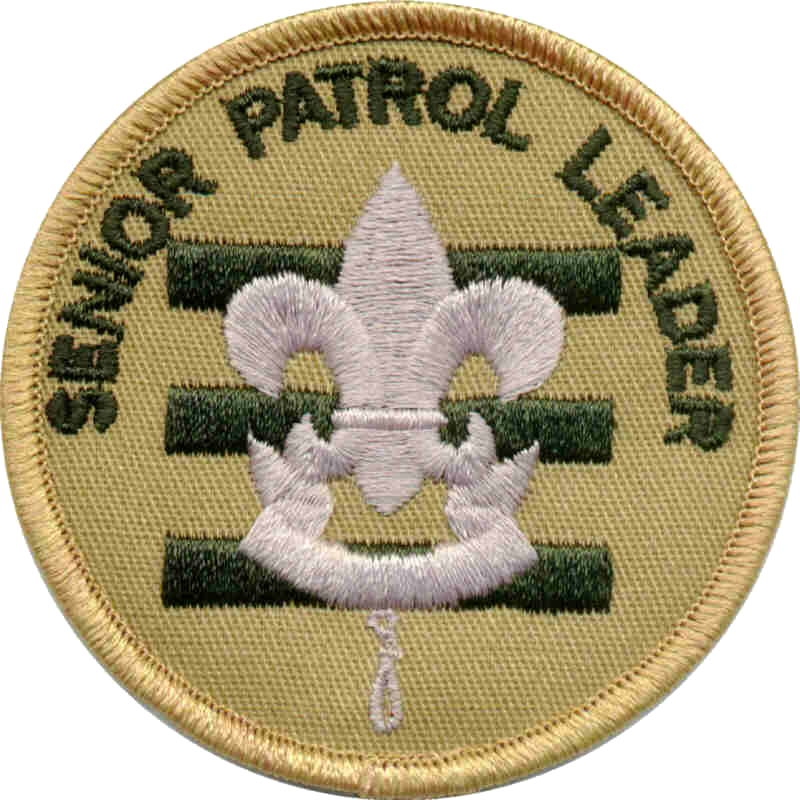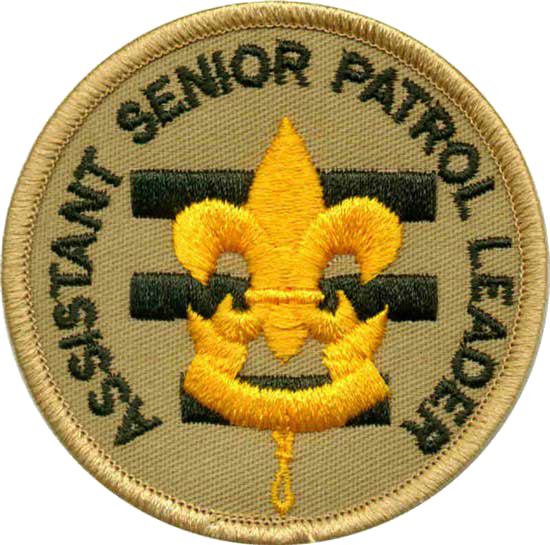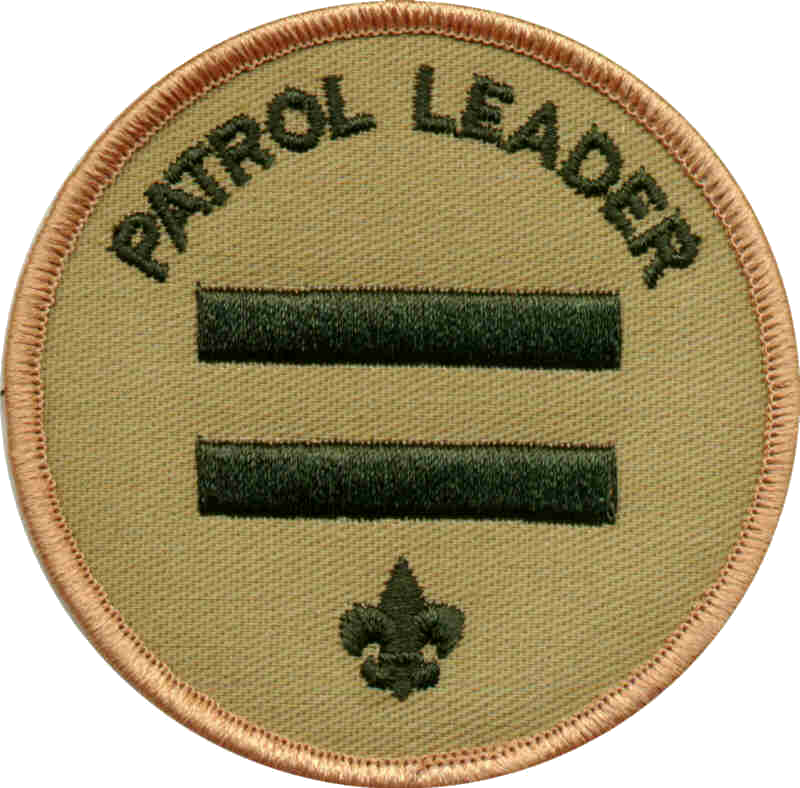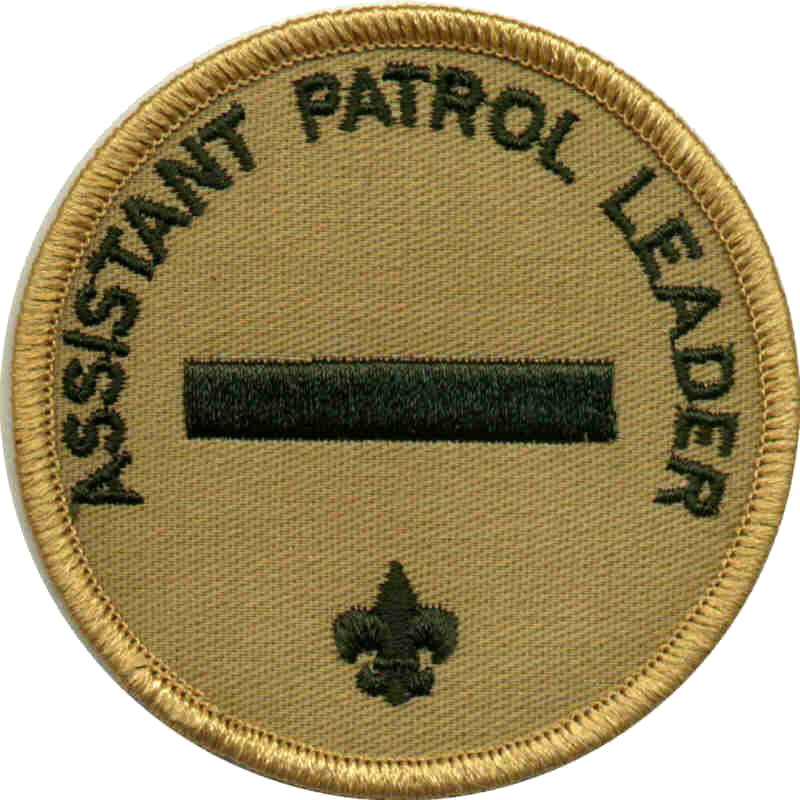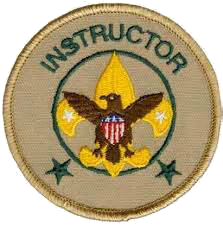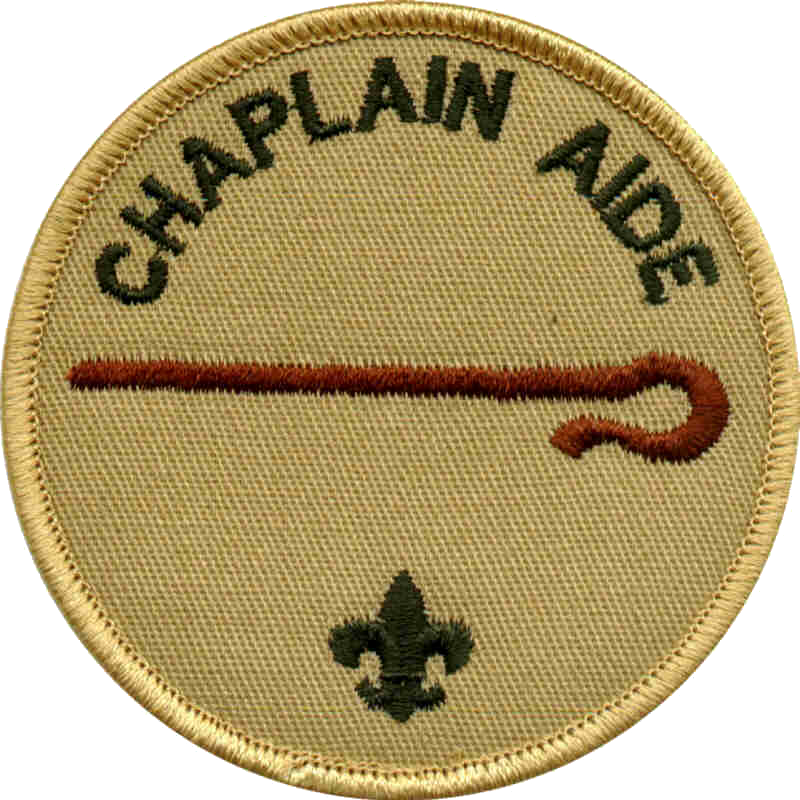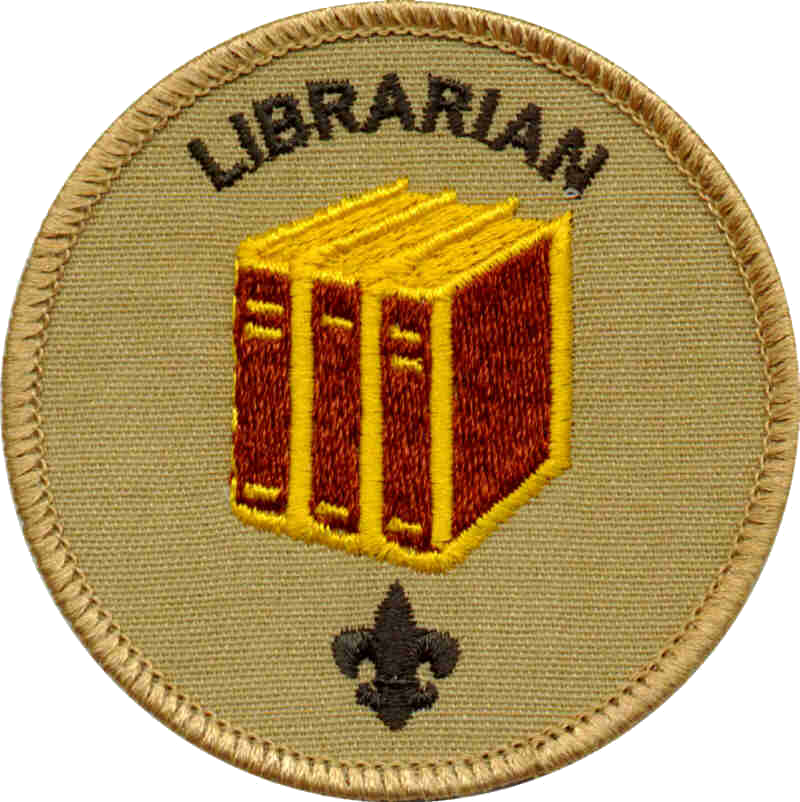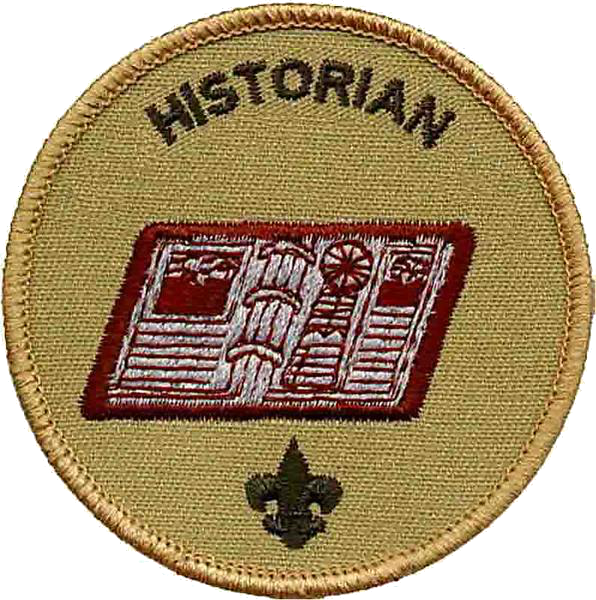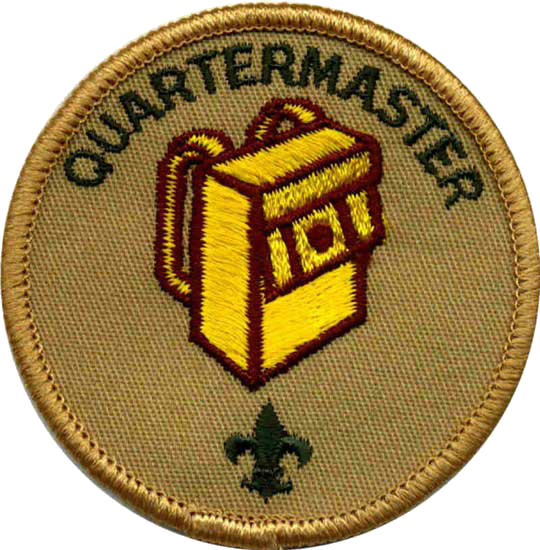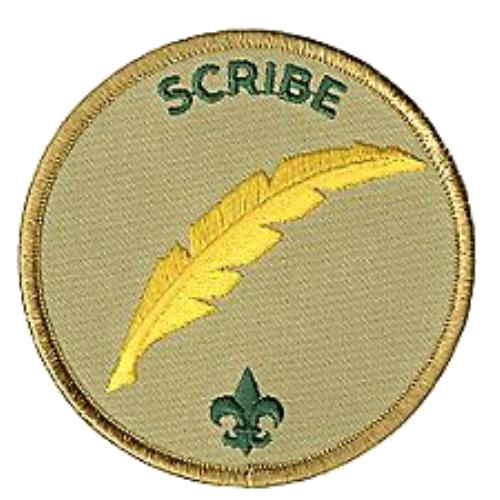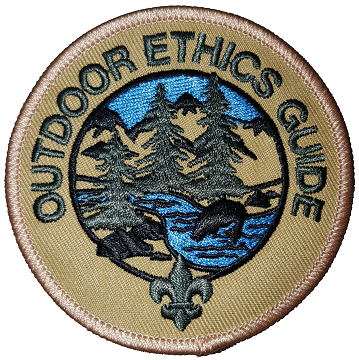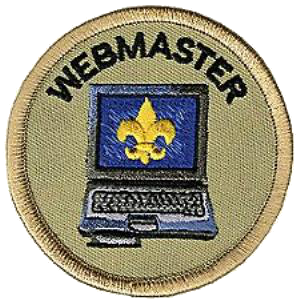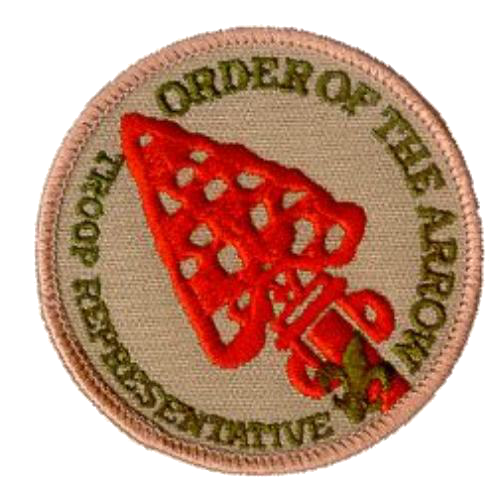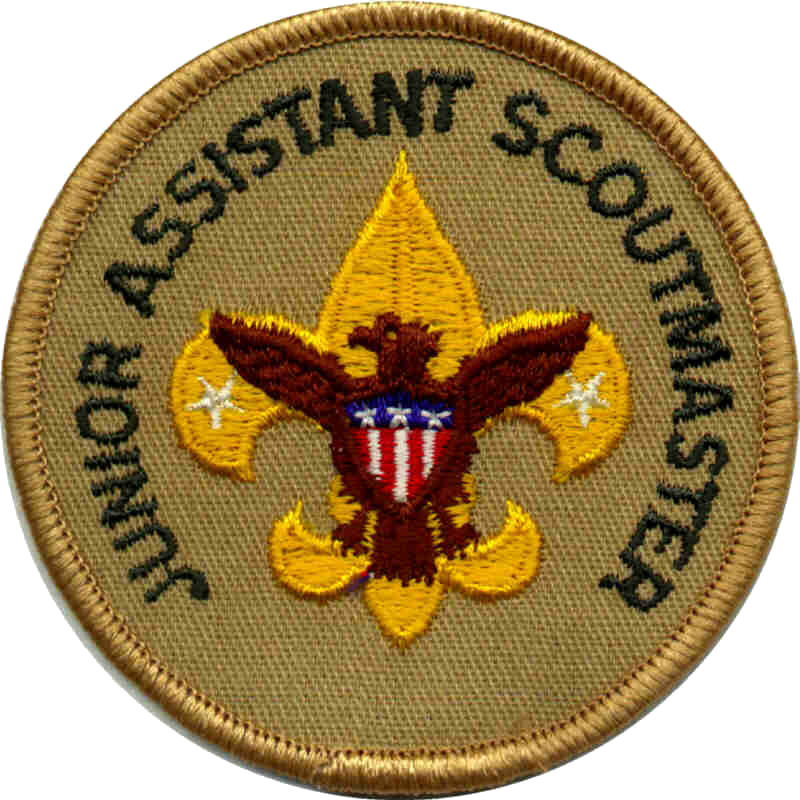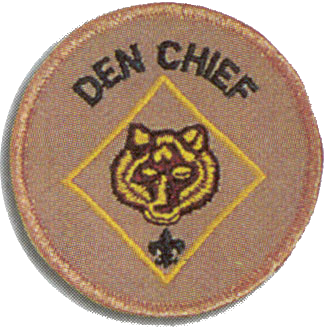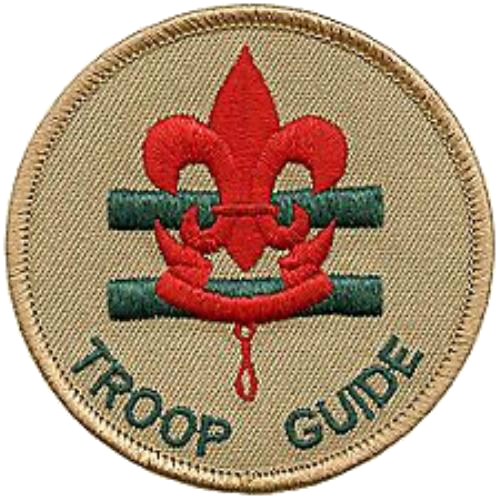Appendix C
Junior Leader Job Descriptions

RECOMMENDED QUALIFICATIONS
Age: 14 or older
Rank: Star or higher
Experience: Previous service as SPL, ASPL, PL, APL, Troop Guide, Scribe, Den Chief, Quartermaster, and / or Instructor
Membership: Must be a member in good standing with the troop
PERFORMANCE REQUIREMENTS
Training: Must attend the Leadership Skills for Troops Training even if he attended in the past.
Attendance: Is expected to attend all Patrol Leaders' Council meetings, sixteen or more troop meetings (~75%), and five or more campouts (~85%) during his tenure. If his attendance is low or performance is not up to expectations for his position, he may be removed from office.
Effort: Expected to give this job his best effort.
GENERAL LEADERSHIP RESPONSIBILITIES
Uniform: Sets the good example by wearing his uniform correctly. This means wearing all of the parts of the Troop uniform, shirttail tucked in, with all required badges in their correct locations.
Behavior: Sets the good example by living the Scout Oath and Law in his everyday life. Shows Scout Spirit in everything he says and does. Helps develop Scout Spirit in others. Sets and enforces the tone for good Scout behavior within the troop.
Attendance: Sets the good example by being an active Scout and being on time for meetings and activities. He must call the Scoutmaster if he is going to miss a meeting or if he suddenly has to miss an outing. Also, needs to ensure his Assistant Senior Patrol Leader is ready to assume his responsibilities in his absence.
SPECIFIC LEADERSHIP RESPONSIBILITIES
- Presides over all Troop meetings, events, activities, and the annual program planning conference.
- Chairs the Patrol Leaders' Council meeting.
- Appoints junior leaders with the advice, counsel, and consent of the Scoutmaster.
- Assigns duties and responsibilities to junior leaders.
- Works with the Scoutmaster in training Scout leaders.

Description: The Assistant Senior Patrol Leader is the second highest-ranking patrol leader in the Troop. The Assistant Senior Patrol Leader acts as the Senior Patrol Leader in the absence of the SPL or when called upon. He also provides leadership to other junior leaders in the Troop.
Comments: The most important part of the ASPL position is his work with the other junior leaders. The ASPL should be familiar with the other positions and stay current with the work being done.
RECOMMENDED QUALIFICATIONS
Age: 14 or older
Rank: First Class or higher
Experience: Previous service as ASPL, PL, APL, Troop Guide, Scribe, Den Chief, Quartermaster, and / or Instructor
Membership: Must be a member in good standing with the troop
PERFORMANCE REQUIREMENTS
Training: Must attend the Leadership Skills for Troops Training even if he attended in the past.
Attendance: Is expected to attend all Patrol Leaders' Council meetings, sixteen or more troop meetings (~75%), and five or more campouts (~85%) during his tenure. If his attendance is low or performance is not up to expectations for his position, he may be removed from office.
Effort: He is expected to give this job his best effort.
GENERAL LEADERSHIP RESPONSIBILITIES
Uniform: Sets the good example by wearing his uniform correctly. This means wearing all of the parts of the Troop uniform, shirttail tucked in, with all required badges in their correct locations.
Behavior: Sets the good example by living the Scout Oath and Law in his everyday life. Shows Scout Spirit in everything he says and does. Helps develop Scout Spirit in others. Assists in setting and enforcing the tone for good Scout behavior within the troop.
Attendance: Sets the good example by being an active Scout and being on time for meetings and activities. He must call the Senior Patrol Leader if he is not going to be at a meeting or if he suddenly has to miss an outing. He also needs to be ensure that another scout is available and prepared to assume his responsibilities in his absence.
SPECIFIC LEADERSHIP RESPONSIBILITIES
- Responsible for training and giving direct leadership to the historian, Order of the Arrow troop representative, scribe, librarian, instructor, quartermaster, chaplain aide, outdoor ethics guide, and webmaster.
- Helps to lead meetings and activities as called upon by the senior patrol leader.
- Guides the troop in the senior patrol leader's absence.
- Serves as a member of the Patrol Leaders' Council.
- Performs tasks assigned by the senior patrol leader.

Description: The Patrol Leader is the elected leader of his Patrol. He represents his Patrol on the Patrol Leaders' Council.
Comments:The Patrol Leader may easily be the most important job in the Troop. He has the closest contact with the Patrol members and is in the perfect position to help and guide them. The Patrol Leaders, along with the Senior Patrol Leader and Assistant Senior Patrol Leader are the primary members of the Patrol Leaders' Council.
RECOMMENDED QUALIFICATIONS (waived for New Scout Patrol)
Age: 13 or older
Rank: Second Class or higher
Experience: Previous service as PL, APL, Troop Guide, Scribe, Den Chief, Quartermaster, and / or Instructor
Membership: Must be a member in good standing with the troop
PERFORMANCE REQUIREMENTS
Training: Must attend the Leadership Skills for Troops Training even if he attended in the past.
Attendance: Is expected to attend all Patrol Leaders' Council meetings, sixteen or more troop meetings (~75%), and five or more campouts (~85%) during his tenure. If his attendance is low or performance is not up to expectations for his position, he may be removed from office.
Effort: He is expected to give this job his best effort.
GENERAL LEADERSHIP RESPONSIBILITIES
Uniform: Sets the good example by wearing his uniform correctly. This means wearing all of the parts of the Troop uniform, shirttail tucked in, with all required badges in their correct locations.
Behavior: Sets the good example by living the Scout Oath and Law in his everyday life. Shows Scout Spirit in everything he says and does. Helps develop Scout Spirit in others. Assists in setting and enforcing the tone for good Scout behavior within the troop.
Attendance: Sets the good example by being an active Scout and being on time for meetings and activities. He must call the Senior Patrol Leader or Scoutmaster if he is not going to be at a meeting or if he suddenly have to miss an outing. He also ensures that the Assistant Patrol Leader is ready to assume his responsibilities.
SPECIFIC LEADERSHIP RESPONSIBILITIES
- Plans and lead patrol meetings and activities.
- Keeps patrol members informed.
- Assigns each patrol member needed tasks and help them succeed.
- Represents the patrol at all patrol leaders' council meetings and the annual program planning conference.
- Prepares the patrol to take part in all troop activities.
- Shows and helps develop patrol spirit.
- Works with other troop leaders to make the troop run well.
- Knows what patrol members and other leaders can do.

Description: The Assistant Patrol Leader leads the patrol when the Patrol Leader is absent.
Comments: Substituting for the Patrol Leader is only part of the Assistant Patrol Leader's job. The APL actively helps run the patrol.
RECOMMENDED QUALIFICATIONS (waived for New Scout Patrol)
Age: None
Rank: Second Class or higher
Experience: Previous service as APL, Troop Guide, Scribe, Den Chief, Quartermaster, and / or Instructor
Membership: Must be a member in good standing with the troop
PERFORMANCE REQUIREMENTS
Training: Must attend the Leadership Skills for Troops Training even if he attended in the past.
Attendance: Is expected to attend all Patrol Leaders' Council meetings in the absence of his Patrol Leader, sixteen or more troop meetings (~75%), and four or more campouts (~65%) during his tenure. If his attendance is low or performance is not up to expectations for his position, he may be removed from office.
Effort: He is expected to give this job his best effort.
GENERAL LEADERSHIP RESPONSIBILITIES
Uniform: Sets the good example by wearing his uniform correctly. This means wearing all of the parts of the Troop uniform, shirttail tucked in, with all required badges in their correct locations.
Behavior: Sets the good example by living the Scout Oath and Law in his everyday life. Shows Scout Spirit in everything he says and does. Helps develop Scout Spirit in others. Assists in setting and enforcing the tone for good Scout behavior within the troop.
Attendance: Sets the good example by being an active Scout and being on time for meetings and activities. He must call the Patrol Leader or Scoutmaster if he is not going to be at a meeting or if he suddenly has to miss an outing. He also needs to be ensure that another scout is available and prepared to assume his responsibilities.
SPECIFIC LEADERSHIP RESPONSIBILITIES
- Helps the patrol leader plan and lead patrol meetings and activities.
- Helps the patrol leader keep patrol members informed.
- Helps the patrol leader prepare the patrol to take part in all troop activities.
- Leads the patrol in the patrol leader's absence.
- Represents the patrol at all patrol leaders' council meetings in the patrol leader's absence.
- Works with other troop leaders to make the troop run well.

Description: The Instructor teaches Scouting skills.
Comments: The Instructor will work closely with both the Troop Guide and with the Assistant Scoutmaster for new Scouts. The Instructor does not have to be an expert but should be able to teach the Scoutcraft skills needed for Tenderfoot, Second Class, and First Class ranks. The Troop can have more than one Instructor.
RECOMMENDED QUALIFICATIONS
Age: 14 or older
Rank: Star or higher
Experience: None
Membership: Must be a member in good standing with the troop
PERFORMANCE REQUIREMENTS
Training: Must attend the Leadership Skills for Troops Training even if he attended in the past.
Attendance: Is expected to attend sixteen or more troop meetings (~75%) and four or more campouts (~65%) during his tenure. If his attendance is low or performance is not up to expectations for his position, he may be removed from office.
Effort: He is expected to give this job his best effort.
GENERAL LEADERSHIP RESPONSIBILITIES
Uniform: Sets the good example by wearing your uniform correctly. This means wearing all of the parts of the Troop uniform, shirttail tucked in, with all required badges in their correct locations.
Behavior: Sets the good example by living the Scout Oath and Law in his everyday life. Shows Scout Spirit in everything he says and does. Helps develop Scout Spirit in others. Assists in setting and enforcing the tone for good Scout behavior within the troop.
Attendance: Sets the good example by being an active Scout and being on time for meetings and activities. He must call the Senior Patrol Leader or Scoutmaster if he is not going to be at a meeting or if he suddenly has to miss an outing. He also needs to be ensure that another scout is available and prepared to assume his responsibilities.
SPECIFIC LEADERSHIP RESPONSIBILITIES
- Instructs Scouting skills as needed within the troop or patrols.
- Prepares well in advance for each teaching assignment.

Description: The Chaplain Aide works with the Troop Chaplain to meet the religious needs of Scouts in the Troop. He also works to promote the religious awards program.
Comments: "Duty to God" is one of the core beliefs of Scouting. The Chaplain Aide helps everyone in the Troop by preparing short religious observations for campouts and other functions. The Chaplain Aide does not always lead the observation himself and can have other Troop members help.
RECOMMENDED QUALIFICATIONS
Age: None
Rank: None
Experience: None
Membership: Must be a member in good standing with the troop
PERFORMANCE REQUIREMENTS
Training: Must attend the Leadership Skills for Troops Training even if he attended in the past.
Attendance: Is expected to attend sixteen or more troop meetings (~75%) and four or more campouts (~65%) during his tenure. If his attendance is low or performance is not up to expectations for his position, he may be removed from office.
Effort: He is expected to give this job his best effort.
GENERAL LEADERSHIP RESPONSIBILITIES
Uniform: Sets the good example by wearing his uniform correctly. This means wearing all of the parts of the Troop uniform, shirttail tucked in, with all required badges in their correct locations.
Behavior: Sets the good example by living the Scout Oath and Law in his everyday life. Shows Scout Spirit in everything he says and does. Helps develop Scout Spirit in others. Assists in setting and enforcing the tone for good Scout behavior within the troop.
Attendance: Sets the good example by being an active Scout and being on time for meetings and activities. He must call the Assistant Senior Patrol Leader or Scoutmaster if he is not going to be at a meeting or if he suddenly has to miss an outing. He also needs to be ensure that another scout is available and prepared to assume his responsibilities.
SPECIFIC LEADERSHIP RESPONSIBILITIES
- Keeps troop leaders apprised of religious holidays when planning activities.
- Assists the troop chaplain or religious coordinator in meeting the religious needs of troop members while on activities.
- Encourages saying grace at meals while camping or on activities.
- Leads worship services on campouts.
- Tells troop members about the religious emblems program for their faith.

Description: The Troop Librarian takes care of Troop literature.
Comments: The library contains books of historical value as well as current materials. All together, the library is a Troop resource worth hundreds of dollars. The Librarian manages this resource for the Troop.
RECOMMENDED QUALIFICATIONS
Age: None
Rank: None
Experience: None
Membership: Must be a member in good standing with the troop
PERFORMANCE REQUIREMENTS
Training: Must attend the Leadership Skills for Troops Training even if he attended in the past.
Attendance: Is expected to attend sixteen or more troop meetings (~75%) and four or more campouts (~65%) during his tenure. If his attendance is low or performance is not up to expectations for his position, he may be removed from office.
Effort: He is expected to give this job his best effort.
GENERAL LEADERSHIP RESPONSIBILITIES
Uniform: Sets the good example by wearing his uniform correctly. This means wearing all of the parts of the Troop uniform, shirttail tucked in, with all required badges in their correct locations.
Behavior: Sets the good example by living the Scout Oath and Law in his everyday life. Shows Scout Spirit in everything he says and does. Helps develop Scout Spirit in others. Assists in setting and enforcing the tone for good Scout behavior within the troop.
Attendance: Sets the good example by being an active Scout and being on time for meetings and activities. He must call the Assistant Senior Patrol Leader or Scoutmaster if he is not going to be at a meeting or if he suddenly has to miss an outing. He also needs to be ensure that another scout is available and prepared to assume his responsibilities.
SPECIFIC LEADERSHIP RESPONSIBILITIES
- Establishes and maintain a troop library.
- Keeps records on literature owned by the troop.
- Adds new or replacement items as needed.
- Has literature available for borrowing at troop meetings.
- Maintains a system to check literature in and out.
- Follows up on late returns.

Description: The Troop Historian keeps a historical record or scrapbook of Troop activities.
Comments: The true value of a good Historian does not show up until years later. The Historian provides material for displays and presentations of current activities. In addition, the work of the Historian provides a link with the past.
RECOMMENDED QUALIFICATIONS
Age: None
Rank: None
Experience: None, but interest in photography is helpful
Membership: Must be a member in good standing with the troop
PERFORMANCE REQUIREMENTS
Training: Must attend the Leadership Skills for Troops Training even if he attended in the past.
Attendance: Is expected to attend sixteen or more troop meetings (~75%) and four or more campouts (~65%) during his tenure If his attendance is low or performance is not up to expectations for his position, he may be removed from office.
Effort: He is expected to give this job his best effort.
GENERAL LEADERSHIP RESPONSIBILITIES
Uniform: Sets the good example by wearing his uniform correctly. This means wearing all of the parts of the Troop uniform, shirttail tucked in, with all required badges in their correct locations.
Behavior: Sets the good example by living the Scout Oath and Law in his everyday life. Shows Scout Spirit in everything he says and does. Helps develop Scout Spirit in others. Assists in setting and enforcing the tone for good Scout behavior within the troop.
Attendance: Sets the good example by being an active Scout and being on time for meetings and activities. He must call the Assistant Senior Patrol Leader or Scoutmaster if he is not going to be at a meeting or if he suddenly has to miss an outing. He also needs to be ensure that another scout is available and prepared to assume his responsibilities.
SPECIFIC LEADERSHIP RESPONSIBILITIES
- Gathers pictures and facts about past activities of the troop and keep them in scrapbooks, wall displays, or information files.
- Takes care of troop trophies and keepsakes.
- Keeps information about troop alumni.

Description: The Troop Quartermaster keeps track of Troop equipment and sees that it is in good working order.
Comments: The Quartermaster does most of his work around camp outs. There are times when the Quartermaster has to be available to check equipment in and out.
RECOMMENDED QUALIFICATIONS
Age: None
Rank: None
Experience: None
Membership: Must be a member in good standing with the troop
PERFORMANCE REQUIREMENTS
Training: Must attend the Leadership Skills for Troops Training even if he attended in the past.
Attendance: Is expected to attend sixteen or more troop meetings (~75%) and four or more campouts (~65%) during his tenure. If his attendance is low or performance is not up to expectations for his position, he may be removed from office.
Effort: He is expected to give this job his best effort.
GENERAL LEADERSHIP RESPONSIBILITIES
Uniform: Sets the good example by wearing his uniform correctly. This means wearing all of the parts of the Troop uniform, shirttail tucked in, with all required badges in their correct locations.
Behavior: Sets the good example by living the Scout Oath and Law in his everyday life. Shows Scout Spirit in everything he says and does. Helps develop Scout Spirit in others. Assists in setting and enforcing the tone for good Scout behavior within the troop.
Attendance: Sets the good example by being an active Scout and being on time for meetings and activities. He must call the Assistant Senior Patrol Leader or Scoutmaster if he is not going to be at a meeting or if he suddenly has to miss an outing. He also needs to be ensure that another scout is available and prepared to assume his responsibilities.
SPECIFIC LEADERSHIP RESPONSIBILITIES
- Keeps records of patrol and troop equipment.
- Keeps equipment in good repair.
- Keeps equipment storage area neat and clean.
- Issues equipment and see that it is returned in good order.
- Suggests new or replacement items.
- Works with the troop committee member responsible for equipment.

Description: The Scribe keeps the Troop records. He records the activities of the Patrol Leaders' Council and keeps a record of dues, advancement, and Scout attendance at Troop meetings.
Comments: To be a good Scribe you need to attend nearly all Troop and Patrol Leaders' Council meetings.
RECOMMENDED QUALIFICATIONS
Age: None
Rank: None
Experience: None
Membership: Must be a member in good standing with the troop
PERFORMANCE REQUIREMENTS
Training: Must attend the Leadership Skills for Troops Training even if he attended in the past.
Attendance: Is expected to attend all Patrol Leaders' Council meetings, sixteen or more troop meetings (~75%), and four or more campouts (~65%) during his tenure. If his attendance is low or performance is not up to expectations for his position, he may be removed from office.
Effort: He is expected to give this job his best effort.
GENERAL LEADERSHIP RESPONSIBILITIES
Uniform: Sets the good example by wearing his uniform correctly. This means wearing all of the parts of the Troop uniform, shirttail tucked in, with all required badges in their correct locations.
Behavior: Sets the good example by living the Scout Oath and Law in his everyday life. Shows Scout Spirit in everything he says and does. Helps develop Scout Spirit in others. Assists in setting and enforcing the tone for good Scout behavior within the troop.
Attendance: Sets the good example by being an active Scout and being on time for meetings and activities. He must call the Assistant Senior Patrol Leader or Scoutmaster if he is not going to be at a meeting or if he suddenly has to miss an outing. He also needs to be ensure that another scout is available and prepared to assume his responsibilities.
SPECIFIC LEADERSHIP RESPONSIBILITIES
- Attends and keep a log of patrol leaders' council meetings.
- Records attendance and dues payments of all troop members.
- Records advancement in troop records and on the troop advancement chart.
- Works with the appropriate troop committee members responsible for finance, records, and advancement.
- Handles correspondence appropriately.

Description: The Outdoor Ethics Guide teaches Scouting skills.
Comments: The Outdoor Ethics Guide specializes in teaching Leave No Trace / TREAD Lightly! principles and ensuring that the troop follows these principles on outings. He helps Scouts earn the Center for Outdoor Ethics award. He has a thorough understanding of—and commitment to—Leave No Trace / TREAD Lightly! principles. Ideally, he will have completed Leave No Trace Trainer course and earned the Camping and Environmental Science merit badges.
RECOMMENDED QUALIFICATIONS
Age: 12 or older (base age requirement to attend the BSA Leave No Trace Trainer Course is 14)
Rank: First Class or higher
Experience: None
Membership: Must be a member in good standing with the troop
PERFORMANCE REQUIREMENTS
Training: Must attend the Leadership Skills for Troops Training even if he attended in the past. He must complete the on-line "Leave No Trace Awareness Course" and the "TREAD Lightly! Awareness Course". "The one hour BSA Outdoor Ethics Orientation" (taught by local BSA council staff) and the two day "BSA Leave No Trace Trainer Course" (also taught by local BSA council staff) are highly recommended!
Attendance: Is expected to attend sixteen or more troop meetings (~75%) and four or more campouts (~65%) during his tenure. If his attendance is low or performance is not up to expectations for his position, he may be removed from office.
Effort: He is expected to give this job his best effort.
GENERAL LEADERSHIP RESPONSIBILITIES
Uniform: Sets the good example by wearing his uniform correctly. This means wearing all of the parts of the Troop uniform, shirttail tucked in, with all required badges in their correct locations.
Behavior: Sets the good example by living the Scout Oath and Law in his everyday life. Shows Scout Spirit in everything he says and does. Helps develop Scout Spirit in others. Assists in setting and enforcing the tone for good Scout behavior within the troop.
Attendance: Sets the good example by being an active Scout and being on time for meetings and activities. He must call the Assistant Senior Patrol Leader or Scoutmaster if he is not going to be at a meeting or if he suddenly has to miss an outing. He also needs to be ensure that another scout is available and prepared to assume his responsibilities.
SPECIFIC LEADERSHIP RESPONSIBILITIES
- Helps the troop plan and conduct an outdoor program that emphasizes effectively practicing the principles of outdoor ethics.
- Supports Scouts who are working to complete the relevant requirements for the Tenderfoot, Second Class and First Class ranks.

Description: The Troop Webmaster assists in maintenance and update of the troop web site.
Comments: The troop webmaster is responsible for assisting the adult responsible for the maintenance and update of the troop's web site. He ensures that information posted on the web site is correct and up to date and that individual members' and leaders' privacy is respected and protected.
RECOMMENDED QUALIFICATIONS
Age: None
Rank: None
Experience: None
Membership: Must be a member in good standing with the troop
PERFORMANCE REQUIREMENTS
Training: Must attend the Leadership Skills for Troops Training even if he attended in the past.
Attendance: Is expected to attend sixteen or more troop meetings (~75%) and four or more campouts (~65%) during his tenure. If his attendance is low or performance is not up to expectations for his position, he may be removed from office.
Effort: He is expected to give this job his best effort.
GENERAL LEADERSHIP RESPONSIBILITIES
Uniform: Sets the good example by wearing his uniform correctly. This means wearing all of the parts of the Troop uniform, shirttail tucked in, with all required badges in their correct locations.
Behavior: Sets the good example by living the Scout Oath and Law in his everyday life. Shows Scout Spirit in everything he says and does. Helps develop Scout Spirit in others. Assists in setting and enforcing the tone for good Scout behavior within the troop.
Attendance: Sets the good example by being an active Scout and being on time for meetings and activities. He must call the Assistant Senior Patrol Leader or Scoutmaster if he is not going to be at a meeting or if he suddenly has to miss an outing. He also needs to be ensure that another scout is available and prepared to assume his responsibilities.
SPECIFIC LEADERSHIP RESPONSIBILITIES
- Assists the adult troop webmaster in maintenance and update of a safe and secure troop web site and ensure the troop website is a positive reflection of the troop and Scouting for the public.
- Works with the adult troop webmaster responsible for the maintenance and update of the troop's web site to ensure that information posted on the web site is correct and up to date and that individual members' and leaders' privacy is respected and protected.
- Manages the troop's electronic communication tools.
- Works with the Scouts to provide up-to-date troop information.
- Works with the scribe.

Description: The OA Troop Representative acts as a liaison between the Troop and the OA lodge. He works to help communication, encourage Arrowmen to actively participate in the Troop and encourage non-members to seek membership.
Comments: To be a good OA Troop Representative you need to attend nearly all Troop and Patrol Leaders' Council meetings.
RECOMMENDED QUALIFICATIONS
Age: Under 18 years old
Rank: First Class or higher
Experience: Must be an OA member in good standing
Membership: Must be a member in good standing with the troop
PERFORMANCE REQUIREMENTS
Training: Must attend the Leadership Skills for Troops Training even if he attended in the past.
Attendance: Is expected to attend sixteen or more troop meetings (~75%) and four or more campouts (~65%) during his tenure If his attendance is low or performance is not up to expectations for his position, he may be removed from office.
Effort: He is expected to give this job his best effort.
GENERAL LEADERSHIP RESPONSIBILITIES
Uniform: Sets the good example by wearing his uniform correctly. This means wearing all of the parts of the Troop uniform, shirttail tucked in, with all required badges in their correct locations.
Behavior: Sets the good example by living the Scout Oath and Law in his everyday life. Shows Scout Spirit in everything he says and does. Helps develop Scout Spirit in others. Assists in setting and enforcing the tone for good Scout behavior within the troop.
Attendance: Sets the good example by being an active Scout and being on time for meetings and activities. He must call the Assistant Senior Patrol Leader or Scoutmaster if he is not going to be at a meeting or if he suddenly has to miss an outing. He also needs to be ensure that another scout is available and prepared to assume his responsibilities.
SPECIFIC LEADERSHIP RESPONSIBILITIES
- Serves as a communication link between the lodge or chapter and the troop.
- Encourages year-round and resident camping in the troop.
- Encourages older-Scout participation in high-adventure programs.
- Encourages Scouts to actively participate in community service projects.
- Assists with leadership skills training in the troop.
- Encourages Arrowmen to assume leadership positions in the troop.
- Encourages Arrowmen in the troop to be active participants in lodge and/or chapter activities and to seal their membership in the Order by becoming Brotherhood members.

RECOMMENDED QUALIFICATIONS
Age: At least 16 years old
Rank: Eagle
Experience: Previous leadership positions
Membership: Must be a member in good standing with the troop
PERFORMANCE REQUIREMENTS
Training: Must attend the Leadership Skills for Troops Training even if he attended in the past.
Attendance: Is expected to attend sixteen or more troop meetings (~75%) and four or more campouts (~65%) during each six month period of his tenure. If his attendance is low or performance is not up to expectations for his position, he may be removed from office.
Effort: He is expected to give this job his best effort.
GENERAL LEADERSHIP RESPONSIBILITIES
Uniform: Sets the good example by wearing his uniform correctly. This means wearing all of the parts of the Troop uniform, shirttail tucked in, with all required badges in their correct locations.
Behavior: Sets the good example by living the Scout Oath and Law in his everyday life. Shows Scout Spirit in everything he says and does. Helps develop Scout Spirit in others. Assists in setting and enforcing the tone for good Scout behavior within the troop.
Attendance: Sets the good example by being an active Scout and being on time for meetings and activities. He must call the Senior Patrol Leader or Scoutmaster if he is not going to be at a meeting or if he suddenly has to miss an outing. He also needs to be ensure that another scout is available and prepared to assume his responsibilities.
SPECIFIC LEADERSHIP RESPONSIBILITIES
- Although not and adult leader, functions in the same capacity as an Assistant Scoutmaster, save for the leadership responsibilities reserved for adults 18 and 21 years of age or older.
- Performs duties as assigned by the Scoutmaster.

Description: The Den Chief works with the Cub Scouts, WEBELOS Scouts, and Den Leaders in the Cub Scout pack.
Comments: The Den Chief provides knowledge of games and Scout skills that many Den Leaders lack. The Den Chief is also a recruiter for the Troop. This function is important because no Troop can thrive without new members and most new members will come from Cub Scouting.
RECOMMENDED QUALIFICATIONS
Age: 12 or older
Rank: First Class or higher
Experience: None
Membership: Must be a member in good standing with the troop
PERFORMANCE REQUIREMENTS
Training: Must attend the Leadership Skills for Troops Training even if he attended in the past.
Attendance: Is expected to attend troop meetings as time and schedule permit and three or more campouts (~50%) during his tenure. Regarding his Den, he is expected to attend ~75% of Den meetings and ~25% of Den / Pack outings. He must inform the Den Leader if he will be absent. If his attendance is low or performance is not up to expectations for his position, he may be removed from office.
Effort: He is expected to give this job his best effort.
GENERAL LEADESHIP RESPONSIBILITIES
Uniform: Sets the good example by wearing his uniform correctly. This means wearing all of the parts of the Troop uniform, shirttail tucked in, with all required badges in their correct locations.
Behavior: Sets the good example by living the Scout Oath and Law in his everyday life. Shows Scout Spirit in everything he says and does. Helps develop Scout Spirit in others. Assists in setting and enforcing the tone for good Scout behavior within the troop.
Attendance: Sets the good example by being an active Scout and being on time for meetings and activities. He must call the Senior Patrol Leader or Scoutmaster if he is not going to be at a meeting or if he suddenly has to miss an outing. He also needs to be ensure that another scout is available and prepared to assume his responsibilities.
SPECIFIC LEADERSHIP RESPONSIBILITIES
- Serves as the activities assistant at den meetings.
- Meets regularly with the den leader to review the den and pack meeting plans.
- If serving as a Webelos den chief; help prepare boys to join Boy Scouting.
- Projects a positive image of Boy Scouting and serves a friend to the boys in the den.

Description: The Troop Guide works with new Scouts. He helps them feel comfortable and earn their First Class rank in their first year.
Comments: The first year as a Boy Scout is a critical time with new places, new people, new rules, and new activities. The Troop Guide is a friend to the new Scouts and makes their first year fun and successful. This is a vitally important position in a growing troop.
RECOMMENDED QUALIFICATIONS
Age: 13 or older
Rank: Star or higher
Experience: Previous service as PL, APL, Troop Guide, Scribe, Den Chief, Quartermaster, and / or Instructor
Membership: Must be a member in good standing with the troop
PERFORMANCE REQUIREMENTS
Training: Must attend the Leadership Skills for Troops Training even if he attended in the past.
Attendance: Is expected to attend all Patrol Leaders' Council meetings while assigned to a New Scout Patrol, sixteen or more troop meetings (~75%), and five or more campouts (~85%) during his tenure. If his attendance is low or performance is not up to expectations for his position, he may be removed from office.
Effort: He is expected to give this job his best effort.
GENERAL LEADERSHIP RESPONSIBILITIES
Uniform: Sets the good example by wearing his uniform correctly. This means wearing all of the parts of the Troop uniform, shirttail tucked in, with all required badges in their correct locations.
Behavior: Sets the good example by living the Scout Oath and Law in his everyday life. Shows Scout Spirit in everything he says and does.
Attendance: Sets the good example by being an active Scout and being on time for meetings and activities. He must call the Senior Patrol Leader or Scoutmaster if he is not going to be at a meeting or if he suddenly has to miss an outing. He also needs to be ensure that another scout is available and prepared to assume his responsibilities.
SPECIFIC LEADERSHIP RESPONSIBILITIES
- Introduces new Scouts to troop operations.
- Guides new Scouts through early Scouting activities.
- Helps set and enforce the tone for good Scout behavior within the troop.
- Ensure solder Scouts never harass or bully new Scouts.
- Helps new Scouts earn the First Class rank in their first year.
- Coaches the patrol leader of the new-Scout patrol on his duties.
- Works with the patrol leader at patrol leaders' council meetings.
- Attends patrol leaders' council meetings with the patrol leader of the new-Scout patrol.
- Assists the assistant Scoutmaster with training.
- Coaches individual Scouts on Scouting challenges.
- Teaches basic Scout skills.
